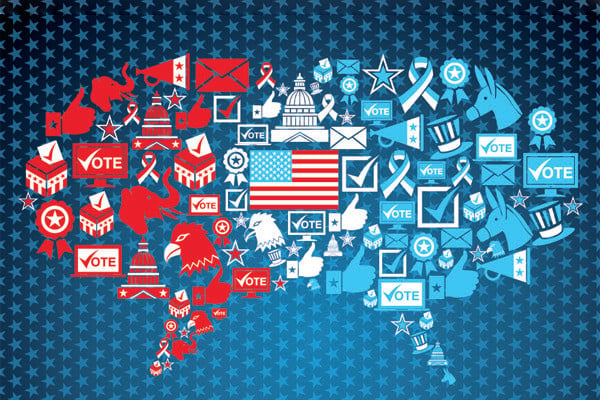Unveiling the Influence of Technology and Emotional Drivers on America's Divisions
What you need to know:
- Rising Political Divide: Emotional responses, fueled by factors like affective polarization and tribalism, are intensifying political divisions in America.
- Technological Influence: Technology, particularly social media and fragmented media sources, exacerbates polarization by reinforcing existing beliefs and limiting exposure to diverse viewpoints.
- Psychological Drivers: Psychological processes like othering and moralization contribute to political sectarianism, deepening divisions and hindering compromise.
- Impact on Society: Political polarization has significant societal consequences, affecting discourse, governance, and societal cohesion, and requires attention and action to address.
Why is this happening, and what's influencing the current situation? As America's political landscape becomes increasingly polarized, understanding the driving forces behind this divide is paramount. We can work through the complexities influencing the political climate of the country by looking into societal dynamics and emotional triggers.
Understanding the Intensifying Political Divide in America
Due to emotional reactions that influence policy preferences and stoke hostility between opposing groups, American politics have become more polarized than they have ever been. A study in the Annual Review of Political Science shows that affective polarization, characterized by a deep-seated disdain for political adversaries, has become increasingly pervasive, exacerbating tensions and hindering constructive discourse.
Tribalism further deepens this divide, as individuals gravitate towards like-minded groups and adopt an "us versus them" mentality. In a thesis for St. Catherine University, Suzanne Damberg writes that tribalistic mindset fosters contempt and hostility towards rival factions, perpetuating a cycle of polarization and ideological entrenchment.
Media split-ups just make things worse by trapping us in our own little thought bubbles. With social media blowing up and news channels taking sides, it's like we're living in echo chambers. And guess what? It's not helping us come together one bit. This tech isolation just digs us deeper into our divides, making it even harder to find common ground. Some of these ideological bubbles are found on social platforms, as one Brookings article suggests, further entrenches polarization and undermines efforts towards consensus-building.
In confronting the intensifying political divide in America, it is imperative to address these underlying factors and foster a climate of empathy, understanding, and constructive dialogue. Media companies such as PBS have attempted to tackle this topic over the years. It is noted that only through concerted efforts to bridge divides and promote mutual respect can the nation navigate towards a more unified and inclusive political landscape.
Emotional Underpinnings of Political Polarization
Affective polarization and tribalism intertwine, shaping policy preferences and fostering divisive "us versus them" mentalities, as described in an article from the Washington Post. This emotional tangle stirs the pot in our social circles and ramps up the divide between us. Meanwhile, the media landscape, with its fragmented pieces and social media swirl, only adds to the chaos. And unfortunately, political players aren't shy about exploiting these emotions, making matters worse and perpetuating the cycle of polarization.
Structural and Psychological Factors Contributing to Polarization

In understanding the multifaceted nature of political polarization, it is essential to examine both structural dynamics and psychological underpinnings. Structurally, the American political system plays a pivotal role in polarization, with its two-party dynamics and winner-take-all elections often fostering an environment of "out-group" hatred and discouraging compromise. This system perpetuates a zero-sum game mentality, which studies say are particularly evident in high-stakes contests such as the presidency, where there are no consolation prizes for the loser.
Concurrently, psychological factors contribute significantly to political sectarianism, with processes like "othering," aversion, and moralization playing crucial roles. The Scientific American reports that othering involves defining people from different groups as inferior, leading to prejudice and discrimination.
Aversion fosters a sense of disgust or distaste towards individuals from other groups, hindering cooperation and promoting conflict. Moralization reinforces a belief in the moral superiority of one's own group, often leading to a sense of entitlement and a lack of respect towards others. Together, these structural and psychological factors deepen political divisions, challenging the fabric of democratic discourse and governance.
Case Study: Donald Trump and Polarization
Donald Trump's Role: Donald Trump's tenure as president was marked by divisive rhetoric and tactics that capitalized on existing political polarization. His strategies often included inflammatory language, racially charged remarks, and the creation of an "us versus them" narrative to rally his base and solidify support among his followers.
Impact: Trump's approach to politics had a significant impact on deepening existing divides within American society, according to the Washington Post. His tactics not only widened the gap between political factions but also intensified emotional responses and hostility between them. Trump's ability to mobilize his base through polarizing rhetoric heightened tensions and further entrenched partisan divisions, contributing to the increasingly fragmented political landscape in the United States.
Summary
In conclusion, America's political landscape presents a complex interplay of structural, psychological, and technological factors. From the entrenched two-party system to the pervasive "us versus them" mentality, navigating these challenges is no easy task. Moreover, the influence of social media exacerbates these divisions, adding another layer of complexity to the equation.
As we look to the future, it's evident that these dynamics will continue to shape elections and societal discourse for the foreseeable future. With technology evolving and tensions rising, addressing these issues is essential for fostering unity and progress. Let's remain vigilant and committed to bridging these divides as we move forward in this decade and beyond.





